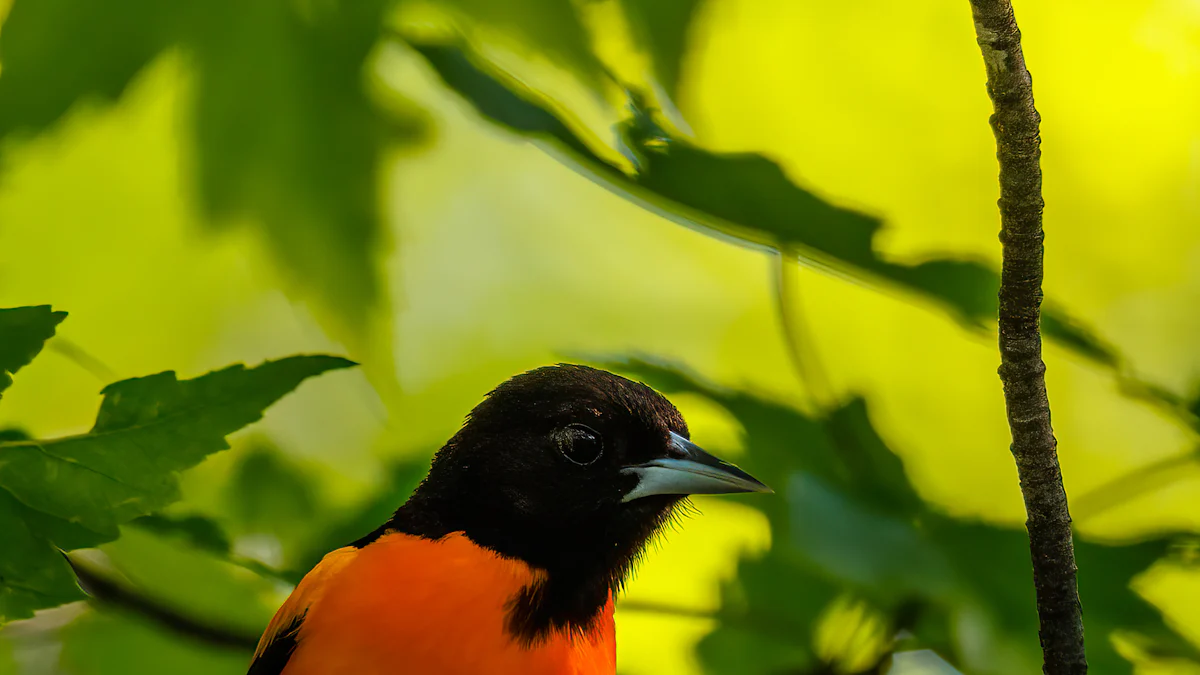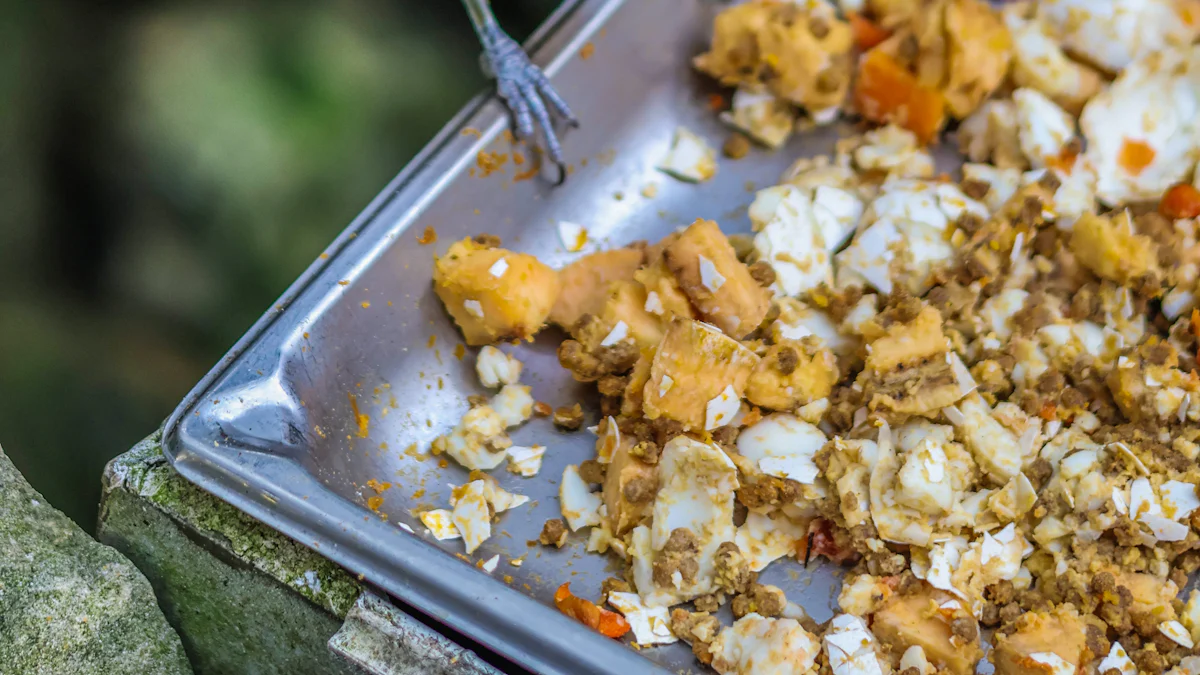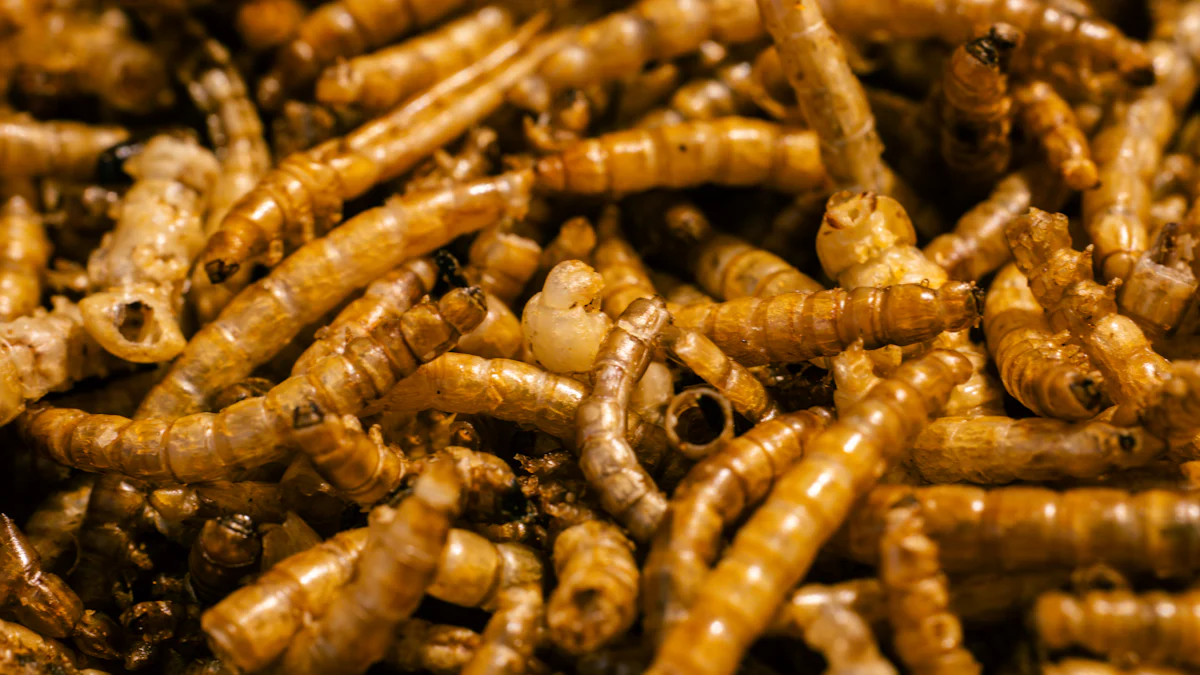
Orioles, with their vibrant plumage and graceful movements, often flit through orchards and woodlands in search of food. In the wild, they rely on insects and fruits to fuel their active lifestyles. Orioles mealworms, whether live or dried, make an excellent addition to their diet. While orioles may initially favor live mealworms due to their movement, dried mealworms offer a convenient and nutritious alternative. Packed with protein and essential nutrients, they support orioles during critical times like nesting and feeding their young. With the right approach, backyard bird enthusiasts can easily attract these stunning birds using orioles mealworms.
Key Takeaways
- Orioles thrive on a diet rich in protein, making dried mealworms an excellent supplement, especially during nesting and migration seasons.
- Dried mealworms are convenient to store and serve, requiring no special care, which makes them ideal for busy bird enthusiasts.
- Offering mealworms can significantly improve the health and survival rates of young orioles, as they provide essential nutrients for growth.
- To attract orioles, use bright orange feeders and place them in open spaces near trees or water sources for maximum visibility.
- Mixing dried mealworms with other foods like nectar or soaking them in water can help orioles adapt to this food source more easily.
- Consistency in feeding is key; regularly refilling feeders encourages orioles to recognize your yard as a reliable food source.
- Both live and dried mealworms have their benefits, but dried mealworms offer higher protein content and ease of use for backyard feeding.
Why Do Orioles Eat Mealworms?
Orioles, with their striking colors and lively behavior, thrive on a diet rich in insects and fruits. In their natural habitats, such as woodlands and orchards, they dart through the trees, searching for nourishment. Mealworms, whether live or dried, serve as an excellent supplement to their diet. These tiny larvae provide essential nutrients that support orioles during critical periods, like nesting and raising their young. Offering mealworms can also encourage orioles to visit your backyard regularly, especially during the summer months when their need for protein increases.
Nutritional Benefits of Orioles Mealworms
Mealworms pack a powerful nutritional punch for orioles. They are rich in protein, which is vital for muscle development and energy. Protein becomes especially important during the breeding season, as orioles need extra strength to care for their young. Additionally, mealworms contain healthy fats that provide a concentrated energy source, helping orioles stay active throughout the day.
According to bird feeding guides, mealworms also offer a variety of vitamins and minerals. These nutrients contribute to the overall health of orioles, aiding in feather growth, immune system support, and reproductive success. By including mealworms in their diet, orioles can maintain their vibrant plumage and robust health.
For backyard bird enthusiasts, dried mealworms are a convenient way to provide these benefits. Unlike live mealworms, dried ones require no special storage and can be easily added to feeders. This makes them an ideal choice for those looking to attract orioles without the hassle of handling live insects.
How Mealworms Fit into Orioles’ Natural Diet
In the wild, orioles rely heavily on insects as a primary food source. During the nesting season, their diet shifts to include more protein-rich options, such as caterpillars, beetles, and other small invertebrates. Mealworms naturally align with this dietary preference, making them an excellent addition to their feeding routine.
Studies on oriole feeding habits reveal that mealworms mimic the nutritional profile of many insects found in their natural environment. This similarity makes mealworms a suitable alternative, especially when natural insect populations fluctuate due to seasonal changes.
Orioles also consume fruits like oranges and berries, but these foods lack the protein needed for growth and energy. By supplementing their diet with mealworms, orioles can achieve a balanced intake of nutrients. This balance is particularly crucial during mid-June through July, when they are busy raising their young. Offering mealworms during this time ensures that orioles have the resources they need to thrive.
Live vs. Dried Mealworms for Orioles

Orioles, with their vibrant colors and energetic movements, often captivate bird enthusiasts. When it comes to feeding them, both live and dried mealworms offer unique benefits. Understanding these differences can help bird lovers choose the best option for their backyard visitors.
Advantages of Live Mealworms
Live mealworms provide a natural feeding experience for orioles. Their movement mimics the behavior of insects orioles hunt in the wild, making them highly appealing. Orioles instinctively recognize live mealworms as food, which can make it easier to attract them, especially if they are new to your yard.
Live mealworms are particularly beneficial during nesting season. The high moisture content in live mealworms helps keep orioles hydrated while providing essential nutrients. This can be crucial when orioles are feeding their young, as the extra hydration supports the health of both parents and chicks.
However, live mealworms require more effort to maintain. They need proper storage, such as refrigeration, to stay alive. Regular care is necessary to prevent spoilage or escape. For those willing to put in the effort, live mealworms can be a rewarding choice.
Advantages of Dried Mealworms
Dried mealworms offer unmatched convenience. Unlike live mealworms, they do not require refrigeration or daily care. Bird enthusiasts can store them easily without worrying about spoilage. This makes dried mealworms an excellent option for those with busy schedules or limited storage space.
Nutritionally, dried mealworms pack a punch. They contain higher protein levels, around 53%, compared to live mealworms, which have about 20%. This protein boost supports muscle development and energy, especially during critical periods like nesting and migration. Dried mealworms also provide more fat and fiber, promoting overall health and vitality in orioles.
Dried mealworms are versatile and easy to use. They can be placed in feeders or mixed with other foods like nectar to create a treat orioles love. Their long shelf life ensures a reliable food source throughout the year, making them a practical choice for attracting orioles consistently.
Both live and dried mealworms make excellent supplements to an oriole’s diet. While live mealworms offer a more natural feeding experience, dried mealworms provide convenience and superior nutritional value. Choosing between the two depends on personal preference and the level of care one is willing to provide.
How to Feed Dried Mealworms to Orioles

Feeding dried mealworms to orioles can be a rewarding experience for bird enthusiasts. These protein-packed treats not only support the health of orioles but also provide an opportunity to observe their vibrant colors and lively behavior up close. To make the most of this feeding practice, it’s essential to choose the right feeder, place it strategically, and encourage orioles to recognize dried mealworms as a food source.
Choosing the Best Feeder for Orioles Mealworms
Selecting the right feeder plays a crucial role in successfully feeding orioles. Platform feeders or specialized oriole feeders with perches work best for offering dried mealworms. These feeders provide easy access for orioles, allowing them to perch comfortably while enjoying their meal. Some feeders even come with compartments for other treats like oranges or jelly, which orioles love.
A bright orange feeder can be particularly effective in attracting orioles. The color mimics the fruits they naturally seek, making it more likely for them to approach. Additionally, feeders designed specifically for orioles often include features that prevent larger birds from taking over, ensuring the mealworms remain available for their intended visitors.
When choosing a feeder, prioritize durability and ease of cleaning. A clean feeder reduces the risk of spreading diseases among birds and keeps the mealworms fresh and appealing.
Placement Tips for Attracting Orioles
Where you place the feeder can significantly impact its success. Orioles prefer open spaces where they feel safe from predators. Position the feeder in a visible area, such as near trees or shrubs, but avoid placing it too close to dense foliage where predators might hide.
Orioles are naturally drawn to elevated spots. Hanging the feeder at eye level or slightly higher can make it more inviting. If possible, place the feeder near a water source like a birdbath. Orioles enjoy drinking and bathing, and the presence of water can increase their visits.
For those just starting to attract orioles, patience is key. It may take a few days or weeks for orioles to discover the feeder. Regularly checking and refilling the feeder ensures that it remains an enticing option when they do arrive.
Encouraging Orioles to Eat Dried Mealworms
Orioles may initially hesitate to eat dried mealworms, especially if they are accustomed to live insects. To help them adapt, consider mixing dried mealworms with other foods they already enjoy, such as nectar or fruit. This combination can make the mealworms more appealing and familiar.
During nesting season, orioles have a higher demand for protein to support their young. Offering mealworms consistently during this time increases the chances of them accepting dried mealworms. Gradually reducing the amount of other foods while maintaining a steady supply of mealworms can encourage orioles to rely on them as a primary food source.
Another effective strategy involves soaking dried mealworms in water for a few minutes before placing them in the feeder. This rehydration process makes the mealworms softer and closer in texture to live ones, which orioles find more enticing.
Consistency is vital when introducing dried mealworms. Regular feeding schedules help orioles recognize your yard as a reliable food source. Over time, they will associate the feeder with a dependable supply of nutritious mealworms, ensuring frequent visits throughout the season.
Seasonal Feeding Advice for Orioles Mealworms
Feeding orioles mealworms throughout the year can enhance their health and ensure their visits to your backyard. However, their needs change with the seasons. Adjusting your feeding approach based on these changes can make a big difference in supporting these vibrant birds.
Feeding During Nesting Season
Nesting season, typically from mid-June through July, is a critical time for orioles. During this period, they require a high-protein diet to support their energy needs and the growth of their young. Mealworms, whether live or dried, provide an excellent source of protein that helps orioles thrive during this demanding time.
To maximize the benefits, offer mealworms in small amounts but frequently throughout the day. This mimics their natural feeding habits and ensures a steady supply of nutrients. Placing the feeder near trees or shrubs can make it easier for orioles to access food while keeping their nests nearby.
Young orioles depend on protein-rich diets to grow strong and healthy. By providing mealworms during nesting season, you can significantly improve their survival rates.
Soaking dried mealworms in water before placing them in the feeder can make them more appealing. The softened texture resembles live insects, which orioles instinctively recognize as food. Consistency is key—keep the feeder stocked to encourage regular visits.
Feeding During Migration Season
Migration season presents another opportunity to support orioles. As they prepare for their long journeys, orioles need extra energy to fuel their flights. Mealworms, packed with protein and healthy fats, serve as an ideal food source during this time.
Start offering mealworms in early spring when orioles begin their migration back north. Continue through late summer and early fall as they prepare to head south. Position the feeder in open spaces where orioles can easily spot it during their travels. Adding a water source nearby, like a birdbath, can make your yard even more inviting.
Bird enthusiasts often notice increased oriole activity during migration season. Providing mealworms consistently can attract more orioles to your yard, creating lively and memorable interactions.
For migrating orioles, mixing mealworms with other foods like fruit or nectar can enhance their appeal. This variety mimics their natural diet and ensures they get a balanced intake of nutrients. Regularly cleaning the feeder and replenishing the food keeps it fresh and enticing.
By tailoring your feeding practices to the nesting and migration seasons, you can create a welcoming environment for orioles year-round. Watching these stunning birds thrive in your backyard is a rewarding experience for any bird lover.
Benefits of Feeding Mealworms to Orioles
Feeding mealworms to orioles offers a unique opportunity to support these vibrant birds while enjoying their lively presence in your backyard. Whether live or dried, mealworms provide essential nutrients that help orioles thrive during critical periods. Let’s explore how mealworms benefit orioles and enhance your bird-watching experience.
Supporting Orioles During Breeding and Nesting
Breeding and nesting seasons demand a lot from orioles. During this time, they need a protein-rich diet to sustain their energy and nourish their growing chicks. Mealworms, packed with protein and healthy fats, serve as an excellent food source to meet these needs.
Young orioles rely heavily on protein for muscle development and overall growth. Mealworms provide this vital nutrient, ensuring the chicks grow strong and healthy. Studies have shown that birds consuming mealworms during nesting season exhibit more vigorous behavior, which directly impacts the survival rates of their young. By offering mealworms consistently, bird enthusiasts can play a significant role in supporting the next generation of orioles.
“Young orioles depend on protein-rich diets to grow strong and healthy. By providing mealworms during nesting season, you can significantly improve their survival rates.” – Source
To maximize the benefits, consider feeding orioles mealworms in small amounts multiple times a day. This approach mimics their natural feeding habits and ensures a steady supply of nutrients. Soaking dried mealworms in water before offering them can make them softer and more appealing, especially for parent orioles feeding their chicks.
Attracting Orioles to Your Backyard
Mealworms not only support orioles’ health but also make your backyard a magnet for these stunning birds. Orioles are naturally drawn to insects, which form a significant part of their diet, especially during summer months. Adding mealworms to your feeders creates an irresistible invitation for them to visit regularly.
Dried mealworms, in particular, offer unmatched convenience for backyard bird enthusiasts. They are easy to store, require no special care, and can be placed in feeders alongside other treats like fruits or nectar. Orioles often find this combination hard to resist. A bright orange feeder filled with mealworms can further increase your chances of attracting these birds, as the color mimics the fruits they naturally seek.
“Birds that consume dried mealworms tend to exhibit more vigorous behavior, resulting in lively interactions that captivate observers.” – Source
Positioning the feeder strategically enhances its effectiveness. Orioles prefer open spaces where they feel safe, so placing the feeder near trees or shrubs but away from dense foliage works best. Adding a water source nearby, like a birdbath, can make your yard even more inviting.
By incorporating mealworms into your feeding routine, you not only support orioles during critical times but also create a vibrant and dynamic backyard environment. Watching these beautiful birds thrive and interact is a rewarding experience for any bird lover.
Dried mealworms provide a simple yet effective way to support orioles while enjoying their vibrant presence in your yard. These protein-packed treats offer essential nutrients that help orioles thrive during critical times like nesting and migration. By selecting the right feeder, placing it strategically, and adjusting feeding practices seasonally, bird enthusiasts can create a welcoming environment for these stunning birds. Watching orioles dart through the trees and visit feeders becomes a rewarding experience. Start offering dried mealworms today and transform your backyard into a lively haven for orioles.
FAQ
Do orioles eat mealworms?
Yes, orioles eat mealworms. These larvae, which are the immature stage of the darkling beetle, provide a rich source of protein. Mealworms make an excellent addition to an oriole’s diet, especially during nesting and migration seasons when their nutritional needs increase.
What are the preferences of orioles when it comes to live and dried mealworms?
Orioles enjoy both live and dried mealworms, but their preferences can vary. Live mealworms attract orioles with their movement, mimicking the insects they hunt in the wild. Dried mealworms, on the other hand, offer convenience and higher protein content, making them a practical choice for backyard feeding.
Why are dried mealworms beneficial for orioles?
Dried mealworms provide essential protein that supports muscle development and energy. They are especially helpful during breeding and nesting seasons, as they aid in the growth of young orioles. Additionally, dried mealworms are easy to store and serve, making them a convenient option for bird enthusiasts.
When should dried mealworms be offered to orioles?
Dried mealworms are most beneficial during early summer, from mid-June through July. This period coincides with the nesting season when orioles need extra protein to feed their fledglings. Offering mealworms consistently during this time ensures that orioles have the nutrition they need to thrive.
How can I encourage orioles to eat dried mealworms?
To encourage orioles to eat dried mealworms, try mixing them with foods orioles already enjoy, such as nectar or fruit. Soaking dried mealworms in water can also make them softer and more appealing. Consistency in feeding helps orioles recognize your yard as a reliable food source.
What type of feeder works best for offering mealworms to orioles?
Platform feeders or oriole-specific feeders with perches work best for offering mealworms. Bright orange feeders are particularly effective, as the color attracts orioles by mimicking the fruits they naturally seek. Choose a feeder that is easy to clean and durable for long-term use.
Can dried mealworms help attract orioles to my backyard?
Yes, dried mealworms can attract orioles to your backyard. Orioles are naturally drawn to insects, which form a significant part of their diet. Adding mealworms to your feeder, especially during nesting or migration seasons, increases the chances of regular visits from these vibrant birds.
Are dried mealworms better than live mealworms for orioles?
Both options have their advantages. Live mealworms provide a natural feeding experience and hydration, while dried mealworms offer higher protein content and convenience. The choice depends on personal preference and the level of care one is willing to provide.
Do orioles need mealworms year-round?
Orioles benefit most from mealworms during nesting and migration seasons. In other periods, their diet shifts to include more fruits and nectar. Offering mealworms year-round is not necessary, but providing them during critical times ensures orioles receive the nutrition they need.
How do mealworms fit into an oriole’s natural diet?
In the wild, orioles consume a variety of insects, including caterpillars and beetles, especially during nesting season. Mealworms align with this dietary preference, offering a protein-rich supplement. By adding mealworms to their diet, orioles can maintain a balanced intake of nutrients.


